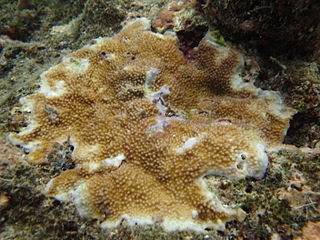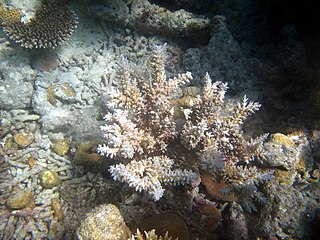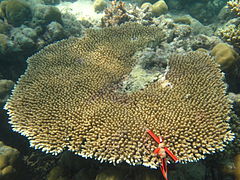
Acropora abrotanoides is a species of acroporid coral found in Indo-Pacific waters from the Red Sea and the Gulf of Aden east to the East China Sea, Japan, the central Pacific Ocean and Australia. It is found in shallow coral reefs that are exposed to the action of strong waves, at depths up to 15 m. It is vulnerable to coral bleaching, disease and crown-of-thorns starfish. It is resistant to predation as it has well-developed radial corallite lips.

Acropora cerealis is a species of acroporid coral found throughout the Indian and Pacific oceans, from the Red Sea and the Gulf of Aden to the Hawaiian Islands and the Johnston Atoll. It can be found on upper reef slopes in shallow tropical reefs, from depths of 3–20 m. Crown-of-thorns starfish preferentially prey upon Acropora corals, and this species is also harvested for the aquarium trade.

Acropora digitifera is a species of acroporid coral found in the Gulf of Aden, the Red Sea, the southwest and northern Indian Ocean, Australia, Southeast Asia, the central Indo-Pacific, Japan, the west Pacific Ocean and the East China Sea. It is found in shallow areas of tropical reefs in the back margins, from depths of 0 to 12 m. It was described by Dana in 1846.

Acropora muricata, commonly called staghorn coral, is a species of acroporid coral found in the Gulf of Aden, the Red Sea, Indian Ocean, Persian Gulf, Australia, central Indo-Pacific, Japan, Southeast Asia, the East China Sea and the oceanic central and western Pacific Ocean. It is found in tropical shallow reefs, slopes of reefs, and in lagoons, from depths of 5 to 30 m. It was described by Dana in 1846.

Acropora globiceps is a species of acroporid coral found in the oceanic central and western Pacific Ocean and central Indo-Pacific. It can also be found in the Great Barrier Reef, the Philippines, the Andaman Islands, Polynesia, Micronesia and the Pitcairn Islands. It occurs on the slopes of reefs, the flats of reefs, in tropical shallow reefs, and at depths of around 8 metres (26 ft). It was described by Dana in 1846.

Acropora granulosa is a species of acroporid coral found in the northern and southwest Indian Ocean, the Red Sea, Australia, the East China Sea, Japan, the oceanic central and western Pacific Ocean, and the central Indo-Pacific. It occurs in tropical shallow reefs, from depths of between 8 and 40 metres. It was described by Milne Edwards in 1860 and is classified as near threatened by the IUCN.

Acropora listeri is a species of acroporid coral found in the Gulf of Aden, the Red Sea, the northern Indian Ocean, Australia, the central Indo-Pacific, Japan, southeast Asia, the East China Sea and the central and western Pacific Ocean. It is also present in Mauritius. The species is found in tropical shallow reefs on their upper slopes, especially in locations exposed to the action of strong waves, at depths of between 3 and 15 metres. It was described by Brook in 1893.

Acropora monticulosa is a species of acroporid coral found in the southwest and northern Indian Ocean, the central Indo-Pacific, Australia, Southeast Asia, Japan, the East China Sea and the oceanic west Pacific Ocean. It is also found in the Tuamotus. It occurs in tropical shallow reefs on upper slopes, from depths of 1 to 12 metres. It was described by Brüggemann in 1879.

Acropora palmerae is a species of acroporid coral found in the northern Indian Ocean, the central Indo-Pacific, Australia, Southeast Asia, Japan, the East China Sea and the oceanic west Pacific Ocean. It is also found in Palau and the Mariana Islands, American Samoa, the Andaman Islands, the Great Barrier Reef, Okinawa Island, Mauritius, Micronesia, the Cook Islands and the Philippines. It occurs in tropical shallow reefs on flats exposed the action of strong waves and in lagoons, from depths of 0 to 12 metres. It was described by Wells in 1954.
Acropora speciosa is a species of acroporid coral found in the Red Sea, the Gulf of Aden, the southwest and northern Indian Ocean, the central Indo-Pacific, Southeast Asia, Japan, the East China Sea, eastern Australia and the oceanic west and central Pacific Ocean. It occurs in shallow reefs at depths of 2 to 25 metres.

Acropora robusta is a species of acroporid coral found in the Red Sea, the Gulf of Aden, the southwest and northern Indian Ocean, the central Indo-Pacific, Australia, Southeast Asia, Japan, the East China Sea and the oceanic west and central Pacific Ocean. It occurs in tropical shallow reefs, mainly along margins that are exposed to the action of strong waves, and can be found at depths from 1 to 8 metres. It was described by Dana in 1846.

Acropora samoensis is a species of acroporid coral found in the Red Sea, the Gulf of Aden, the southwest and northern Indian Ocean, the central Indo-Pacific, Australia, Southeast Asia, Japan, the East China Sea and the oceanic west and central Pacific Ocean. It occurs in tropical shallow reefs on upper slopes of reefs, from depths of 5 to 15 metres. It was described by Brook in 1891.
Acropora striata is a species of acroporid coral found in the southwest Indian Ocean, the central Indo-Pacific, Japan and the East China Sea. It can also be found in the Marshall Islands, the Society Islands, the Cook Islands, Kiribati, the Solomon Islands, western and eastern Australia, the Great Barrier Reef, Palau, the south Mariana Islands and Pohnpei. It occurs in tropical shallow reefs on reef flats or rocky foreshores, at depths of 10 to 25 metres. It probably spawns in October and was described by Verrill in 1866.
Acropora subglabra is a species of acroporid coral found in the northern Indian Ocean, the central Indo-Pacific, Australia, Southeast Asia, Japan, the East China Sea and the oceanic west Pacific Ocean. It occurs in tropical shallow reefs, and its range is often restricted to sheltered back reefs containing soft substrates and clear water. It can be found from depths of 5 to 15 metres and was described by Brook in 1891.
Acropora teres is a species of acroporid coral found in the central Indo-Pacific, Southeast Asia, Japan, the East China Sea and the oceanic western Pacific Ocean. It is found in tropical shallow reefs on slopes and in lagoons, at depths of between 2 and 20 metres. The taxonomic status of this species is uncertain. It was described as Madrepora teres by Verrill in 1866.

Acropora valida is a species of acroporid coral found in the Red Sea, the Gulf of Aden, the southwestern, northwestern and northern Indian Ocean, the Persian Gulf, the central Indo-Pacific, Australia, southeast Asia, Japan, the East China Sea, the oceanic western, central and far eastern Pacific Ocean, the northwestern Hawaiian Islands and Johnston Atoll. It occurs in tropical shallow reefs in a variety of reef habitats, at depths of 1 to 15 metres.

Acropora vaughani is a species of acroporid coral found in the northern Indian Ocean, the central Indo-Pacific, Australia, southeast Asia, Japan, the East China Sea and the oceanic western and central Pacific Ocean. It is also found in Madagascar. It occurs in tropical shallow reefs around fringing reefs in turbid water, at depths of between 3 and 20 metres. It was described by J. W. Wells in 1954.

Acropora verweyi is a species of acroporid coral found in the southwest and northern Indian Ocean, the central Indo-Pacific, Australia, southeast Asia, Japan, the East China Sea and the oceanic western Pacific Ocean. It is also found in the Philippines, American Samoa, Fiji and Rodrigues. It occurs in tropical shallow reefs on upper slopes, from depths of 2 to 15 metres.

Acropora humilis, also known as finger coral, is a species of acroporid coral found in the Gulf of Aden, the Red Sea, the northern and southwestern Indian Ocean, Australia, the central Indo-Pacific, Japan, southeast Asia, the East China Sea, the central and western Pacific Ocean, the Johnston Atoll and the northwestern Hawaiian Islands. It also occurs in the Raja Ampat Islands, Mariana Islands, Palau, and the Pitcairn Islands. Occurring in tropical shallow reefs on upper reef flats and slopes at depths of up to 12 metres (39 ft), it was described by Dana in 1846.

Acropora echinata is a species of acroporid coral that was first described by Dana in 1846. Found in shallow, tropical, sheltered reefs in marine environments, it is found at depths of 8 to 25 m in clear water. The species is listed as vulnerable on the IUCN Red List, and has a decreasing population. It is not common but found over a large area, and is listed under CITES Appendix II.




















